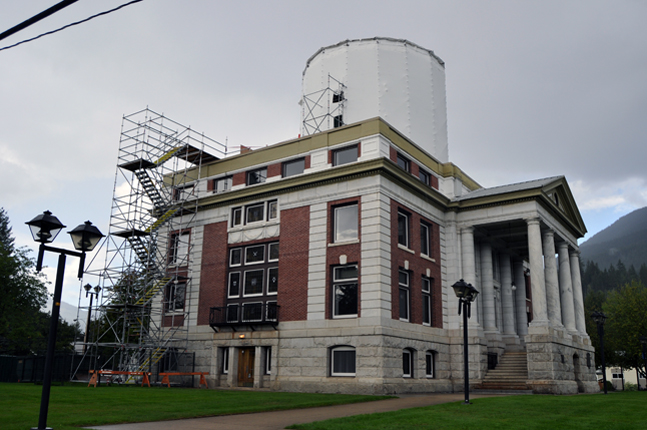
By David F. Rooney
Here’s something that’s bound to make city taxpayers choke: the repairs to the historic Provincial Courthouse dome originally estimated to cost $200,000 have almost doubled to $375,000 because of very high lead levels that officials say consultants failed to inform them about.
“It seems to me someone should be held accountable,” Councillor Chris Johnston said as Council learned about the cost overrun. “I didn’t think we were voting for $375,000 (when Council originally awarded the contract to repair damage to the Courthouse dome and roof). If we had known this in advance we might have gone with a completely different process.”
Although Council had originally liked the idea of repairing the dome’s copper roof with real copper they balked at the price, estimated last year at about $300,000. Councillors thought they were saving big bucks by opting for a polymer film that would coat repairs to the original dome and re-invigorate its colour. Now, as Johnston suggested, some of them are wishing they had stuck with real copper sheathing.
“I think we’re being fleeced,” fumed Councillor Gary Starling of the report that failed to mention that the paint on the dome and roof contained toxic lead levels of 1070 parts per million. That’s high but, historically speaking, house paints in North America contained up to 50% lead before 1955. According to the Agency for Toxic Substances and Disease Registry, federal law in the US lowered the amount of lead allowable in paint to 1% in 1971. Regulations in the US since 1977 have limited the percentage of lead in most paints to 0.06% (600 ppm by dry weight). Paint for bridges and marine use may contain greater amounts of lead.
Lead was used to make paints dry quickly, wear well and to make colors vibrant. The soft, gray metal makes an excellent white pigment. Paint made with white lead pigment provides a high-quality, durable protective coating. The amount and kind of lead vary in different types of paint.
According to Health Canada, paints made before 1950 contained large amounts of lead. In fact, some paint made in the 1940s contained up to 50% lead by dry weight. If your home was built before 1960, it was likely painted with lead-based paint. Since the 1950’s, the use of lead has been more common in exterior paint than interior paint. Subsequently, the use of lead in paints decreased significantly. Currently, under the Hazardous Products Act, lead levels in indoor paint are limited to 0.5 per cent by weight. There are proposed regulatory changes for both interior and exterior consumer paints to limit lead in paints to 0.06 per cent by dry weight. In homes built after 1980, there is little need for concern about lead levels in interior paints. All post-1992 consumer paint produced in Canada or the US for indoor use is virtually lead-free.
The repairs are being conducted by Mid-City, which had bid $200,245, plus GST, to win the repair job. They played no role in the report to Council on the state of the dome.
The discovery of high lead levels pushed back the repairs that were to be completed earlier this summer. Mayor David Raven told Council he understands it should all be wrapped up in three more weeks. As for whether the City might seek some kind of redress for the omission that has apparently cost it $175,000, Mayor Raven said: “It would be premature and inappropriate to discuss recourse options at this time.”
A polymer membrane like the one being applied to the dome has a life expectancy of about 20 years. A copper metal dome would last 80 years.



